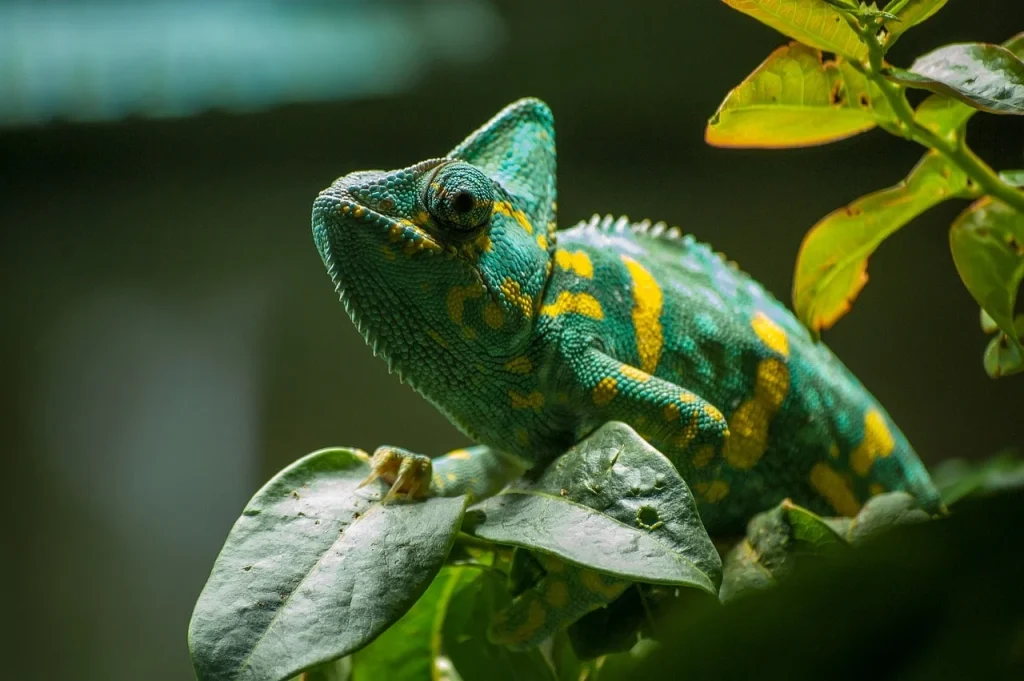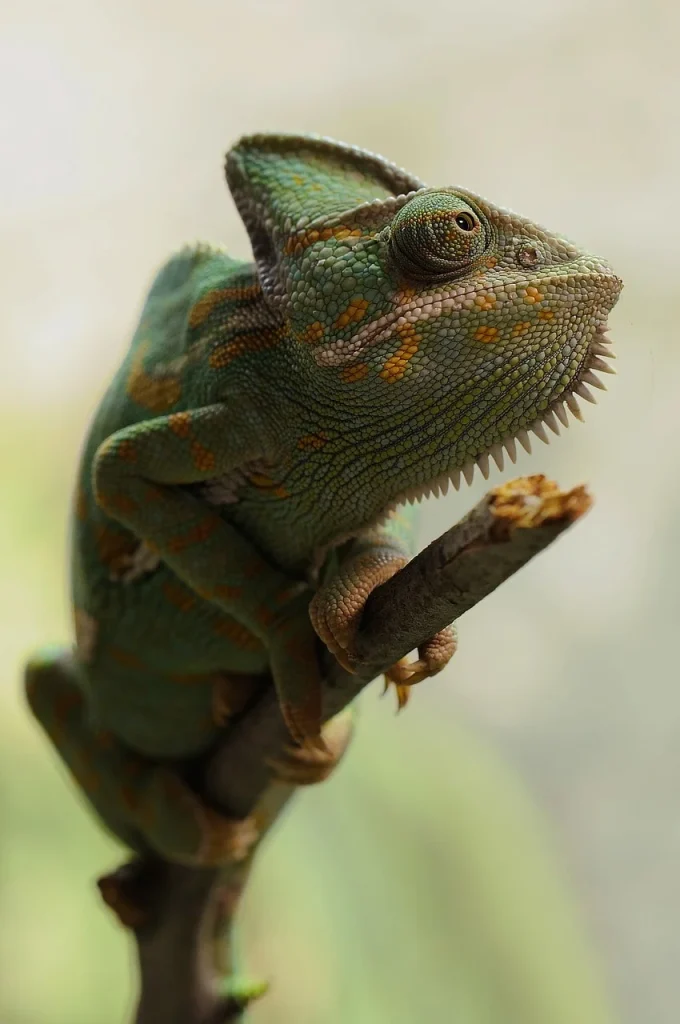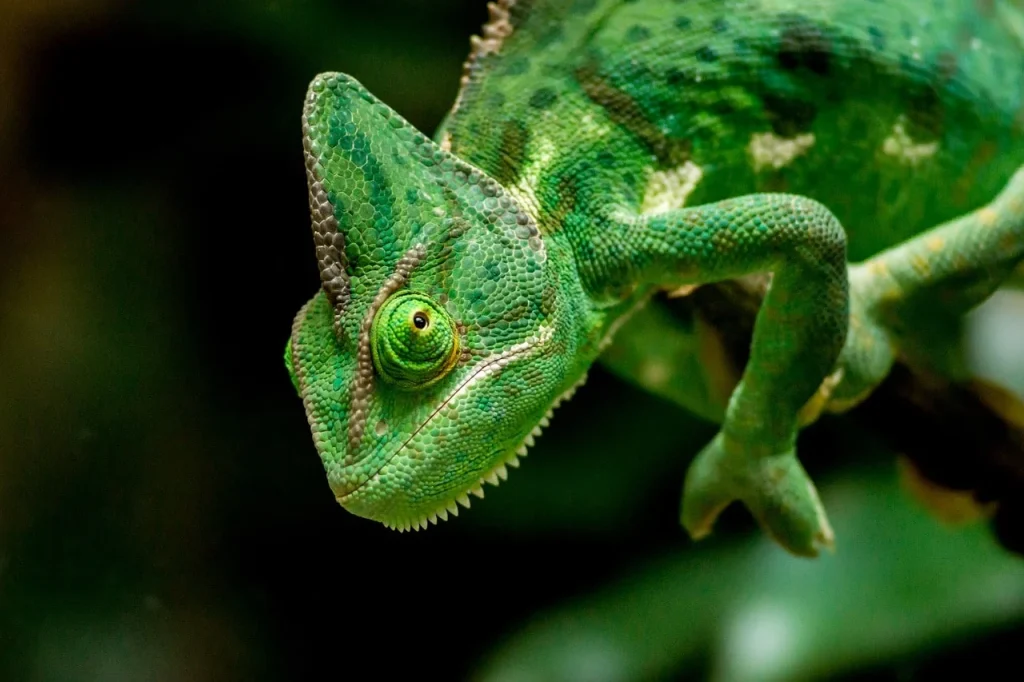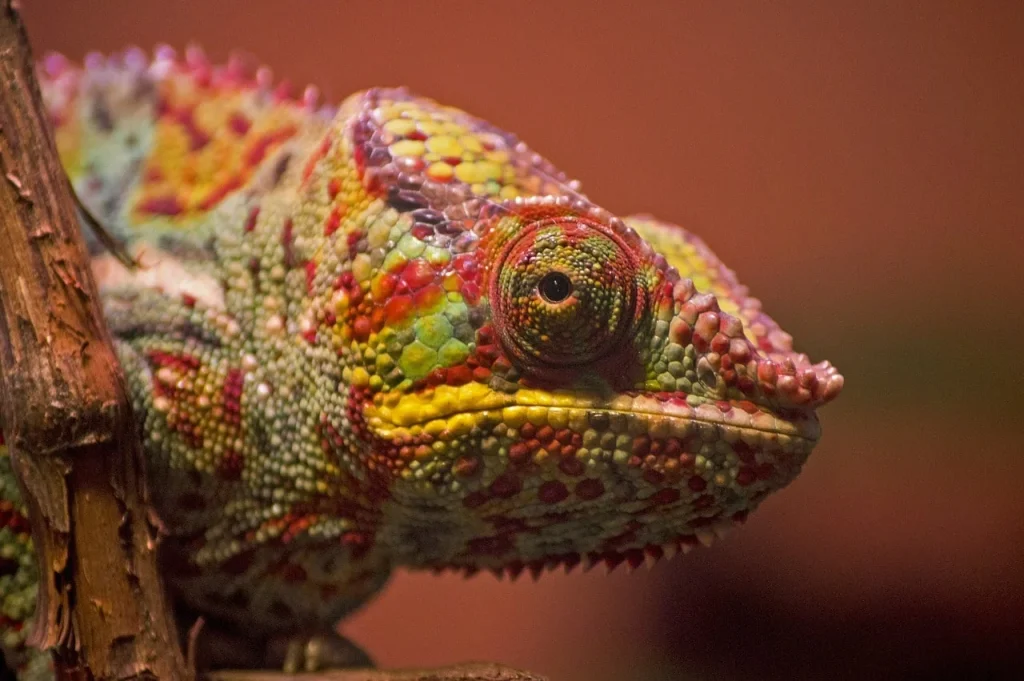Chameleons are the Houdinis of the reptile world, always ready with a color-changing trick up their sleeve—or should we say skin? These fascinating creatures can blend into almost any background, making them the masters of hide and seek.
Did you know that some chameleons can switch their colors in as little as 20 seconds? It’s true! Let’s start our journey and find out more epic facts about these reptile magicians.
Chameleons feed on light and air: Poets’ food is love and fame.
Percy Bysshe Shelley
Chameleon Facts
Welcome to the realm of chameleons! Stay sharp and absorb every fact, as you’ll need it to ace the quiz at the end of the page.
- Some species have tongues that can extend up to twice their body length.
- Their eyes can rotate independently of each other, giving them a 360-degree view of their surroundings.
- They possess a special layer of skin cells called iridophores that reflect light and enable them to change color.
- Their color change isn’t just for camouflage; it also serves purposes such as temperature regulation and communication.
- They can see in both visible and ultraviolet light, enhancing their perception of their environment.
- Unlike most reptiles, some species give birth to live young rather than laying eggs.
- They have a unique foot structure with toes fused into groups, giving them a strong grip on branches.
- Their prehensile tails act like a fifth limb, aiding in balance and climbing.
- Some species can compress their bodies to mimic the shape of leaves, enhancing their camouflage.
- They possess a specialized bone called the hyoid bone that supports their long tongue.
- Their skin can reflect heat, helping them stay cool in hot environments.
- They can remain motionless for long periods, reducing their chances of being detected by predators.
- Some species have a flap of skin called a casque on their head, which helps with water collection.

- They have a high degree of sexual dimorphism, with males often being more brightly colored than females.
- Many species have a lifespan of only a few years in the wild.
- Their eyes are capable of zooming in on prey, similar to a camera lens.
- They can shed their skin in patches, rather than all at once like many other reptiles.
- They communicate with one another through a combination of color changes, body postures, and movements.
- Some species can make a hissing sound to deter predators or rivals.
- They often exhibit a rocking motion when walking to mimic the movement of leaves swaying in the wind.
- Their eggs can take anywhere from four to twelve months to hatch, depending on the species.
- They can consume large quantities of insects, sometimes eating their body weight in a single day.
- In captivity, they require specific humidity and temperature conditions to thrive.
- They have a relatively short digestive tract, adapted for a diet primarily consisting of insects.
- They possess a gland that secretes a sticky substance to help them capture prey with their tongues.
- Their tail can regenerate if lost, although the new tail is often shorter and less functional.
- They can perceive depth and distance with great accuracy, aiding in their hunting strategy.
- They have specialized muscles in their eyes that allow for rapid focus adjustment.

- In some cultures, they are considered symbols of adaptability and change.
- They have been subjects of scientific research due to their unique vision and color-changing abilities.
- They can absorb water through their skin, particularly in humid environments.
- Some species can live at altitudes of up to 3,000 meters in mountainous regions.
- They have a very slow metabolism, which is an adaptation to their typically low-energy diet.
- Their ribs are specially adapted to expand and contract, aiding in respiration.
- Some species can swim, although they generally prefer arboreal habitats.
- They have a third eye, called the parietal eye, which detects light and helps regulate their circadian rhythms.
- Their heart rate can vary significantly, depending on their activity level and environmental conditions.
- They can change the texture of their skin to blend in with rough surfaces.

- They exhibit a high degree of parental care, with some species guarding their eggs until they hatch.
- They can survive for long periods without food, relying on stored body fat.
- Some species are known to consume plant matter, especially during periods of food scarcity.
- They have a keen sense of smell, which aids in locating food and detecting predators.
- They can produce a range of vocalizations, including clicks and chirps, to communicate.
- They are often used in scientific studies related to vision and color perception.
- They have a highly developed pineal gland, which plays a role in their ability to sense light and dark cycles.
- They can lose and regrow their teeth throughout their lives.
- They are capable of rapid bursts of speed when capturing prey, despite their generally slow movements.
- Some species exhibit complex social behaviors, including dominance hierarchies and territory defense.
- They play a crucial role in their ecosystems as both predators and prey, helping to maintain ecological balance.
- Some species are capable of producing mild toxins as a defense mechanism, making them less palatable to predators.
Chameleon Myths

Now that we know the facts about chameleons, let’s separate the truth from the myths surrounding these creatures.
- Chameleons Change Color to Blend into Their Environment
While it’s true that they can change color, they primarily do so to regulate their temperature and communicate their moods or intentions, not just for camouflage. For example, a darker color can help them absorb heat when they are cold. - Chameleons are Social Creatures
They are largely solitary animals. They prefer to live alone and can become stressed by the presence of other chameleons. They only come together for breeding purposes and are otherwise quite territorial. - Chameleons Can Look in Any Direction
They have a unique ability to move each eye independently, allowing them to look in two different directions at once. However, they cannot see directly behind themselves without turning around. - Chameleons Live Only in Deserts and Arid Regions
They primarily inhabit rainforests and other moist, tropical environments. They thrive in areas with abundant vegetation and humidity, which are essential for their survival, rather than arid or solely desert regions. - Chameleons Eat Only Insects
While insects form the bulk of their diet, many chameleons are opportunistic and will eat a variety of other foods when available. Larger chameleons might consume small birds and other lizards to supplement their diet.
Chameleon Quotes

We continue into the quotes section. Feel free to share more quotes in the comments and I will happily add them to the list.
The chameleon changes color to match the earth, the earth doesn’t change color to match the chameleon.
Senegalese Proverb
This proverb uses the chameleon’s adaptive nature to teach a lesson about conforming to the world rather than expecting the world to conform to individual whims.
Chameleons are not survivors because they change color, but because they choose when to change color.
Dean Koontz
Dean Koontz highlights the strategic nature of adaptation, implying that timing and choice are crucial for survival, much like a chameleon’s decision on when to change its color.
Like the chameleon, one eye on the future, one eye on the past.
Malawian Proverb
This Malawian proverb reflects on the wisdom of being aware of both the past and the future, similar to how a chameleon keeps a vigilant watch in multiple directions.
I am a chameleon, so I must suffer the fires of the sun no matter how much they burn me.
Phillip Ridley
Phillip Ridley uses the metaphor of a chameleon to describe personal resilience and the enduring of life’s harsh realities, despite the pain they may bring.
No one can be a chameleon and survive, not for long anyway.
Joan D. Vinge
Joan D. Vinge emphasizes the risks of constantly adapting to others’ expectations, suggesting that authenticity is essential for long-term survival, unlike a chameleon’s constant changes.
Chameleon FAQ

As we approach the FAQ section, remember to read each question carefully. The quiz is just ahead.
- Are chameleons good pets?
They can be fascinating pets for those who appreciate their unique behaviors and needs. However, they’re not ideal for everyone. They require specific care, including regulated temperatures, humidity, and specialized diet, which can be challenging for a first-time pet owner. - Can chameleons swim?
They are not naturally inclined to swim and generally avoid water except for drinking or hydrating through mist. Their bodies are not designed for swimming, and they can easily become stressed or drown if placed in water. - How do chameleons change color?
They change color through specialized cells in their skin called chromatophores, which contain different pigments. Below these, there are cells called iridophores and guanophores that reflect light, adding to the color change. These changes can be triggered by temperature, light, mood, and social signals. - Are chameleons hard to take care of?
They are considered high-maintenance pets due to their specific care requirements. They need a carefully controlled environment with the right humidity, temperature, and lighting. They also need a varied diet of live insects and regular veterinary care to monitor their health. - Can chameleons hear?
They don’t have external ears like mammals, but they aren’t completely deaf. They can detect sound frequencies in a limited range, primarily sensing vibrations. This limited hearing helps them be aware of predators or other changes in their environment.
Chameleon Trivia

Ready for a chameleon quiz? Test your knowledge now! But watch out: score zero, and you’ll find yourself blending into the background with embarrassment!
Conclusion
Finally, the chameleon’s world is a vivid reminder of nature’s ingenuity. Each fact about them—from their color-changing skin to their 360-degree vision—highlights how evolution crafts solutions to life’s challenges.
They not only adapt to their environment; they thrive by being as inconspicuous or as vibrant as their situation demands. Their life in the treetops offers us a metaphor for life: be adaptable, be observant, and sometimes, be bold enough to stand out! Till next time, stay curious and explore more. Cheers.
1 Source Used For This Article

